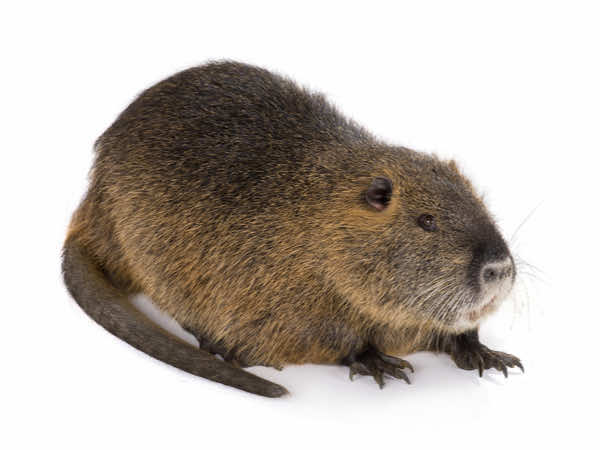Muskrats

Description
- Muskrats eat a wide variety of plants, including cattails, sedges, bulrush, arrowhead, water lilies, pondweed, and ferns. They also eat alfalfa, clover, corn, and other crops if muskrats find them in their territories. Although muskrats will eat shellfish, snails, fish, frogs, and salamanders, such animal foods are a small part of their diet and are generally consumed when plant foods are scarce. Muskrats normally feed within 150 feet of their main dwellings; however, they will travel much farther in search of food. When muskrats become too numerous, an “eat-out” can occur where nearly all the available food is eaten. The eat-out area becomes virtually uninhabitable for muskrats, and only a few animals may be found where dozens or more once were.
Diet
- The muskrat eats aquatic vegetation like cattails, sedges, rushes, water lilies and pond weeds.
Size
- Up to 28 inches in length, Up to 4.5 pounds in weight.
Habitat
- In marshes, ponds, and other water areas, prominent muskrat lodges are sure indicators of a present muskrat population. Look for entrances into their bank dens along with dams, dikes, and stream banks, particularly west of the mountains. Entry holes are particularly evident where muskrats are living in tidewater areas near the mouths of rivers. When the tide recedes, the entrances are exposed until the tide comes back in. Similarly, in dry years the water in ponds and reservoirs can drop and expose den entrances. Muskrats will then usually dig new dens farther out in the pond. Entry holes are 5 to 8 inches in diameter and are located 3 to 36 inches below the surface of the water.
Range
- Muskrats are native to North America, with a range that extends from Canada, down to some northern parts of Mexico.
Lifespan
- A muskrat on average lives about 3-4 years.
Life, History, Reproduction & More
- Although muskrats are important contributors to natural aquatic systems, their burrowing may threaten the safety of dams, dikes, and other human-created embankments. Muskrats may also undermine retaining walls that shore up homes, bridges, and other structures. Muskrats occasionally eat new wetland plantings and agricultural crops growing in their territories. Muskrat numbers may increase to the point where an area is denuded of aquatic plants. After foraging on entire plants, including the roots, they leave the area pitted with digging sites and deep swimming canals. This feeding behavior can destroy existing root mats that bind and secure a wetland together, and the area can be quickly eroded by wind and wave action. Muskrats can transmit Tularemia, a bacterial disease. Tularemia may be transmitted to humans if they drink contaminated water, eat undercooked, infected meat, or allow an open cut to contact an infected animal. The most common source of tularemia for humans is to be cut or nicked by a knife when skinning or gutting an infected animal. Humans can also get this disease via a tick bite, a biting fly, ingestion of contaminated water, or by inhaling dust from soil contaminated with the bacteria. A human who contracts tularemia commonly has a high temperature, headache, body ache, nausea, and sweats. A mild case may be confused with the flu and ignored. Humans can be easily treated with antibiotics. Muskrats are among the few animals that regularly defecate in water, and their droppings (like those of humans and other mammals) can cause a flu-like infection, which old-time trappers referred to as “beaver fever.”
Have a Wildlife Problem?
Call us today or schedule an appointment to find out for yourself why NJ Pest are the experts in wildlife removal and control services. You can count on to get the job done!
